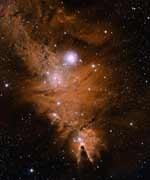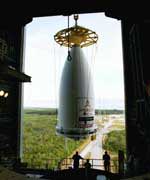
Image credit: NOAO
Season’s Greetings, fellow SkyWatchers! Take the time from your busy holiday schedule to relax with some astronomy. There will be three minor meteor showers this week: the Coma Berenicids, Delta Arietid and the Ursids. The waxing Moon will become our guide as we locate historic variable Mira. Mare Humorum and Crater Gassendi are great features to learn about on the lunar surface and we’ll travel to the outer arm of our own galaxy to study a multiple star system – Sigma Orionis. Not enough? Then I have a special and very challenging surprise for you on Christmas Day! Although the Moon goes full during this seven-day period, those who are just beginning with new telescopes will appreciate its presence as an easy “pointer” to Saturn. So lift your eyes toward the heavens and enjoy the bright stars of Winter…
Because here’s what’s up!
Monday, December 20 – If you’re up early this morning, take a few minutes to watch the skies for the peak of the Coma Berenicid meteor shower. Although the activity for this one is fairly weak, with an average fall rate of about seven per hour, it still warrants study.
So what makes this particular shower of interest? Noted first in 1959, the stream was eventually tied in 1973 to another minor shower bearing the same orbit known as the December Leo Minorids. As we know, meteoroid streams are traditionally tied to the orbit of a comet, and in this case the comet was unconfirmed! Observed in 1912 by B. Lowe, an Australian amateur astronomer, the comet was officially designated as 1913 I and was only seen four times before losing it to sunrise. Using Lowe’s observations, independent researchers computed the comet’s orbit and it was basically forgotten about until 1954. At that time, Fred Whipple was studying meteoroid orbits and made the association between his photographic studies and the enigmatic comet Lowe. By continuing to observe the annual shower, it was derived that the orbital period of the comet was about 75 years, but the two major streams occurred about 27 and 157 years apart. Thanks to the uneven dispersion of material, it may be another decade before we see some real activity from this shower, but even one meteor can make your day!
And if you want to make your “night” an early one, why not trying looking for another odd meteor shower? Tonight will be the peak of the Delta Arietids! These unusual meteors also bear a resemblance to last week’s Geminids, for the source of the stream appears to be a sun-grazing asteroid named Icarus. The hourly fall rate will be about 12 fast and bright “shooting stars”, but the Moon will interfere since it is so close to the radiant. Be sure to watch early as the constellation of Aries will be in the best position for only a few hours after dark. Have a telescope? Then be sure to visit with Madam Selene while out, because the “Straight Wall” will be making its one night stand parallel to the terminator. Look for its thread-thin black shadow just north of the emerging Tycho.
Tuesday, December 21 – This morning marks the point of winter solstice for the northern hemisphere – the time of year where the Sun appears furthest south. For parents, educators or just those who appreciate physically observing the wonders of astronomy, today would be a good time to start a very simple – and very pleasing – experiment. By placing a stake into the ground, or using a stationery object like a fence or sign post, measure the length of the shadow at noon. Write down your measurements, or cut and tag a piece of string with the date. Around every two weeks or so, repeat the process and enjoy the results!
Mira, Mira on the wall… Who’s the strangest star of all? You are, Omicron Ceti. Tonight we’re going to use the nine day old Moon to help guide us to one of the most interesting stars in the sky – Mira! Over 400 years ago, David Fabricus identified Mira, a.k.a. “the Beautiful One”, to be the very first variable star. But what exactly is it? At the time of its discovery, it was thought to be a nova. Cataloged by Bayer seven years later as 4th magnitude Omicron Ceti, imagine the surprise as it “disappeared” from unaided eye visibility! At minimum Mira is around magnitude 9, but within 331 days can flux as high as 3rd or 4th magnitude and has been known to even reach the brightness of Aldeberan.
As a binary system, Mira A is a red giant that goes through some intense changes during its cycle. As one of the coolest of the red stars at minimum, its hot, blue, sub-dwarf companion actually has twice the mass of the primary star. Is it possible that this tiny companion’s extreme gravitation and heat could affect Mira? As Omicron continues to deplete its hydrogen, the interior “pulses” causing it to become more than 100 times brighter and expand more than 700 times the size of our own Sun. In late 1997, Mira became the second star to be resolved by the Hubble Space Telescope and showed a very strange extension towards its companion star.
So how bright will it be tonight? Ah, my friends… That is the joy of discovery!
Wednesday, December 22 – Up early? Fantastic! In the pre-dawn hours of this morning, we have two treats for you – the return of Mercury and the Ursid meteor shower! Cruising around the Sun about every thirteen and a half years, Comet 8P/Tuttle sheds a little skin. Although it never passes inside of Earth’s orbit, some six years later we pass through its debris stream. Not so unusual? Then think again, because it takes as much as six centuries before the meteoroid trail is effected enough by Jupiter’s gravitation to pass into our atmosphere.
Although the Moon will interfere with watching this circumpolar meteor shower, the hours before dawn could see activity of up to 12 per hour. By keeping watch on the constellation of Ursa Major, you just might spot one of these slow moving, 600 year old travelers that make their path only halfway between us and the Moon!
Before dawn this morning, take a look down low on the horizon and say welcome back to Mercury. Above it, and leading the way is bright Venus. For telescopic observers, the real treat will be to see how differently each planet is phased. Venus will appear highly gibbous, while Mercury will only be about one-third illuminated. Keep watch on this pair in the days ahead as they swap places in the sky!
Thursday, December 23 – Tonight exploring the Moon will be in order as one of the most graceful and recognizable lunar features will be prominent – Gassendi. As an ancient mountain walled plane that sits proudly at the northern edge of Mare Humorum, Gassendi sports a bright ring and a triple central mountain peak that are within the range of binoculars. Telescopic viewers will appreciate Gassendi at high power to view how its southern border has been eroded by lava flow and the many riles and ridges that exist inside the crater and the presence of the younger Gassendi A on north wall. While viewing the Mare Humorum area, keep in mind that we are looking at an area about the size of the state of Arkansas. It is believed that a planetoid collision originally formed Mare Humorum. The incredible impact crushed the surface layers of the Moon resulting in a concentric “anticline” that can be traced twice the size of the original impact area. The floor of this huge crater then filled in with lava and was once thought to have a greenish appearance but in recent years have more accurately been described as reddish. That’s one mighty big crater!
Friday, December 24 – Twas the night before Christmas and all through the house, not a creature was stirring… Except for the mouse with the telescope who wants to see a multiple star system! Why don’t we join him tonight and have a look at a very nice and easily resolved, Sigma Orionis.
This particular system is easily found without a map. By identifying the three “belt” stars of Orion, go to the easternmost – Alnitak – and Sigma is the first star south of it. In the telescope you will find a beautiful combination of four stars. The 3.8 magnitude white primary commands attention. With a designation of A/B, this super-massive and extremely bright pair are far too close (about 100 AU apart) to be split with a small scope. Looking 11″ to the southwest, you will discover the 10th magnitude white “C” star and you will see the 7.2 magnitude red “D” star 13″ to the east. Further away yet at a distance of 42″ to the east/northeast is the 6.5 magnitude blue “E” star.
Sharp-eyed observers will also note another multiple system in the same field of view to the northwest. This is Struve 761. As an “all white” system of similar magnitudes, you will see two residing east/west of each other and the third companion to the north. What we are looking at is a system that is about 1,500 light years away from us in the rich, star-forming region of Orion. Give that mouse a piece of cheese!
Saturday, December 25 – In keeping with the season, tonight’s astronomical object is a celebration of both starlight and asterism. Located 10 degrees east of Betelgeuse, the NGC 2264 will be a challenging object thanks to tonight’s near-full Moon, but the results will be quite worth it! Also known as “the Christmas Tree” cluster, this bright asterism of approximately 20 bright stars and over a 100 fainter ones is embroiled in a faint nebula that will be lost to bright skies, leaving only the delightful “Christmas Tree” shape adorned with stars. The very brightest of these stars, S Monoceros, is fifth magnitude and will show clearly in the finder scope and as a double at magnification. Steady skies will reveal that the “star” and the top of our “tree” is also a visual double and home to the beautiful “Cone Nebula”! Many of the stars will also appear to have companions, as well as tints of silver as gold. The visual effect of this splendid open cluster (as seen in this sketch by Jeff Barbour) is well worth the challenge it presents. Happy Holidays!
Sunday, December 26 – Did you get a new telescope? Then enjoy tonight’s full Moon! Although it is very bright, it is also the easiest of astronomical targets and will show many prominent features, bright rays and expansive plains of maria. If you are itching to explore, but unfamiliar with the sky, the Moon will offer to be your guide to one of the most exciting planets for the beginner – Saturn!
With the Moon in the constellation of Gemini tonight, you will see three “stars” gathered to the east. Point your telescope at the southern-most of this trio and enjoy the “Lord of the Rings”. Even small telescopes can appreciate the broad ring system, but there is also a treat tonight as well. Appearing to “follow” Saturn across the sky is its easily spotted moon, Titan!
I would like to thank all of you who have taken the time to write! Your observations of Comet Macholz have been wonderful, so please continue to observe it despite the Moon. I deeply appreciate all the kind words I have received. Do not be afraid to ask questions or share an observation. This column is all about you! Until next week? I wish you the very best of the season. Keep looking up and enjoying the wonders of our Universe! Light speed… ~Tammy Plotner


